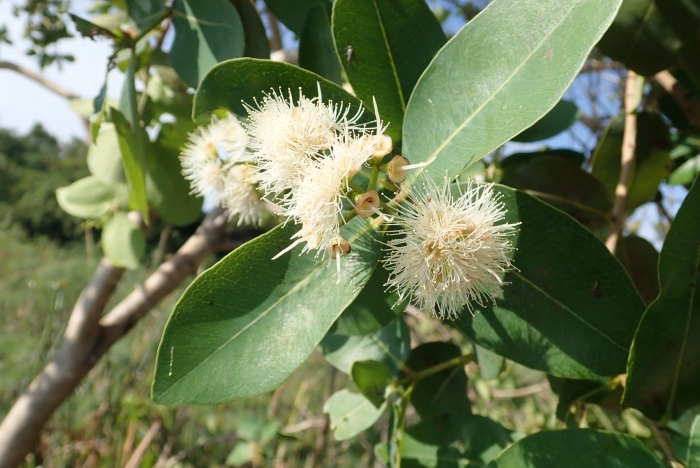Water Berry
(Syzygium cordatum)
Water Berry (Syzygium cordatum)
/
/

Robert Taylor
CC BY 4.0
Image By:
Robert Taylor
Recorded By:
Copyright:
CC BY 4.0
Copyright Notice:
Photo by: Robert Taylor | License Type: CC BY 4.0 | License URL: http://creativecommons.org/licenses/by/4.0/ | Rights Holder: Robert Taylor | Publisher: iNaturalist | Date Created: 2019-12-01T06:29:01Z |

























Estimated Native Range
Summary
Syzygium cordatum, commonly known as Water Berry or umdoni, is an evergreen tree native to the coastal and riparian forests, forest margins, and swampy areas of Southern Africa, from Kwazulu-Natal to Zimbabwe and Mozambique. It typically grows to a height of 26-49 feet (8-15 meters) with a dense, rounded to spreading canopy. The leaves are elliptic to circular, bluish-green, and glossy, contributing to the tree’s ornamental value. Water Berry produces clusters of white to pinkish, sweetly fragrant flowers that attract pollinators, followed by edible, red to dark-purple berries that are favored by birds and other wildlife, as well as being consumed by humans.
The Water Berry tree is valued for its hardiness and adaptability to wet conditions, making it suitable for planting in damp or waterlogged soils. It is used in traditional medicine to treat various ailments, and its dense foliage provides excellent shade, making it a popular choice for gardens and landscapes. In cultivation, it thrives in full sun to partial shade and requires moderate water, preferring rich, well-drained soils. While generally pest-resistant, it can be susceptible to root rot if drainage is poor. The tree’s non-aggressive root system makes it safe for planting near structures.CC BY-SA 4.0
The Water Berry tree is valued for its hardiness and adaptability to wet conditions, making it suitable for planting in damp or waterlogged soils. It is used in traditional medicine to treat various ailments, and its dense foliage provides excellent shade, making it a popular choice for gardens and landscapes. In cultivation, it thrives in full sun to partial shade and requires moderate water, preferring rich, well-drained soils. While generally pest-resistant, it can be susceptible to root rot if drainage is poor. The tree’s non-aggressive root system makes it safe for planting near structures.CC BY-SA 4.0
Plant Description
- Plant Type: Tree
- Height: 15-30 feet
- Width: 15-20 feet
- Growth Rate: Moderate
- Flower Color: White
- Flowering Season: Spring
- Leaf Retention: Evergreen
Growth Requirements
- Sun: Full Sun, Part Shade
- Water: Medium, High
- Drainage: Medium, Slow
Common Uses
Bird Garden, Butterfly Garden, Edible*Disclaimer: Easyscape's listed plant edibility is for informational use. Always verify the safety and proper identification of any plant before consumption., Hedges, Low Maintenance, Water Garden
Natural Habitat
Coastal and riparian forests, forest margins, and swampy areas from Kwazulu-Natal to Zimbabwe and Mozambique
Other Names
Common Names: umDoni, Waterbessie
Scientific Names: , Syzygium cordatum,
GBIF Accepted Name: